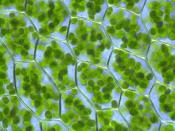Comparison of Plant and Animal Cells Introduction Eukaryotic cells are very complex; there are many organelles, each serving a distinct function, present in eukaryotic cells. We can divide the eukaryotic group of cells in to two main groups, according to the presence of these membrane bound organelles, and the structural differences amongst the cells and their organelles. The two groups of eukaryotic cells are plant and animal cells.
Nucleus The reason that plant and animal cells are not divided in to two different types of cells, and instead are both grouped in the eukaryotic cell group lies in the definition of eukaryotic cells. The word is derived from the Greek "eu" meaning true, and "karyon" referring to the nucleus. This means the eukaryotic cells have "true" membrane-bound nuclei. Both plant and animal cells have a membrane-bound nucleus; hence, they are grouped as eukaryotic cells. The nucleus plays the same role and has the same structure in both plant and animal cells.
You can see that the nucleus is present in both animal and plant cells by examining figure A and figure B.
Although the nucleus itself remains similar among both plant and animal cells, one difference lies in the positioning of the nucleus within the cell. Due to the central vacuole in a plant cell, the nucleus is usually not located in the center of the cell; rather, it is usually crowded nearer the plasma membrane. In most animal cells, however, the nucleus is located in the center of the cell, as this position is ideal in the process of mitosis, and there is no large central vacuole located in animal cells.
The nucleus contains the genes which control the entire cell, and, within the eukaryotic division of cells is uniform among all cells, that is, every eukaryotic cell has...


